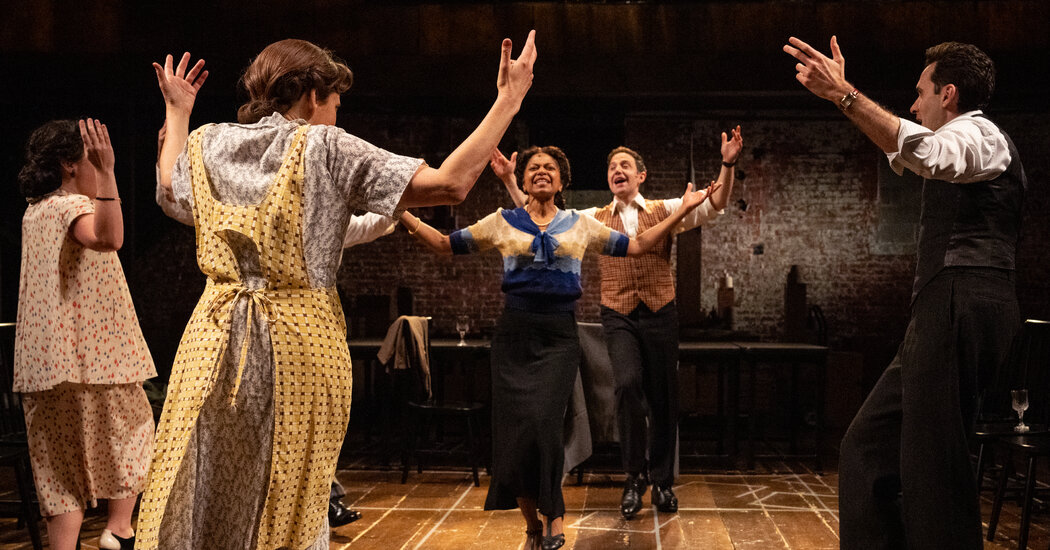What a shame that the 1962 musical “I Can Get It for You Wholesale,” a critique of vulture capitalism disguised as a rag trade comedy, is now best known as the Broadway show that gave Barbra Streisand her start at 19. No matter how good she was — and the recording of her big number, “Miss Marmelstein,” overflows with stupendous, youthful invention — hers was only a small, comic role in a much darker story by the novelist Jerome Weidman; her song a bauble in a fascinating and multifaceted score by Harold Rome.
A clash of styles probably contributed to the show’s meh run. In Weidman’s novel, the main character, a garment industry climber named Harry Bogen, is an impenitent snake, a moral bottom feeder who knows no bottom. (On his way up, he breaks a strike, lies to his mother, dupes his pals, two-times his girlfriend and embezzles from his partners.) Despite the antiheroes of “Pal Joey” and “Carousel” in the 1940s — and “How to Succeed in Business Without Really Trying,” a recent hit when “Wholesale” opened — Bogen was apparently deemed too awful for Broadway, so Weidman softened him. Casting Elliott Gould further dialed up the twinkle.
The revisal of “Wholesale” that opened on Monday at Classic Stage Company was meant, in part, to address the tonal problem, and who better to do it than Weidman’s son John, himself a fine musical librettist. (Two great Sondheim shows are among his credits: “Pacific Overtures” and “Assassins.”) He has restored some of the novel’s first-person narration, so that Harry (Santino Fontana) gets to work his charm directly on the audience. (Fontana being a charmer, he almost succeeds.) Weidman has cut a song, moved two, added three from Rome’s archive and trimmed several others. He’s excised any hint of redemption at the end.
That the show, directed by Trip Cullman, still doesn’t hold together is unfortunate. Its bones are too big for the 196-seat Classic Stage space, which makes the story feel as if it were stuffed into a dress several sizes too small. Likewise, the music is too complex for six players weirdly doubling. The violinist naturally enough plays viola, but also percussion, occasionally at the same time.
This doesn’t matter when the show’s best singers are given its best songs: Judy Kuhn, as Harry’s Yiddishe momme, offers an exquisite “Too Soon”; Rebecca Naomi Jones, as his long-suffering girlfriend, a touching “Who Knows?”; and Joy Woods, as the gold digger he trades up to, a cynical duet called “What’s in It for Me?” (with Greg Hildreth as a salesman). And Julia Lester’s clarion honk in “Miss Marmelstein” recalls Streisand without being a copy. Still, the lack of orchestral texture makes the songs, dotting the highly episodic book, feel like one-offs, not a score.
They were always, admittedly, a disparate bunch, like the this-and-that numbers Rome wrote for his first Broadway outing, the 1936 revue “Pins and Needles.” (Produced by the garment workers’ union, it too was about inequities in the rag trade.) “Wholesale” is more ambitious, as you can hear on the original cast album, with its electrifying orchestrations by Sid Ramin. In that format, Rome’s liberal mixing of smoky jazz with klezmer-like melodies almost coheres, bongos and blue notes banging up against shtetl cantillations. And it’s hard to resist vivid Yiddish-inflected rhymes like “riches” and “shvitzes.”
But in trying to achieve a balance among its various styles, the musical’s book never solved the problem of being too many things at once: a romance with a heel for a hero, a lovingly Jewish show about a Jew behaving badly, a Broadway comedy with a downer of a message. Near the end, “What Are They Doing to Us Now?” — an angry chorale in the Marc Blitzstein manner — offers this advice for future generations: “Don’t get born.”
This revisal doesn’t solve those problems, and makes others worse. Harry’s new narration, though smart, exacerbates the stylistic mishmash. At times, the schmaltz is so thick that we seem to be in the Anatevka of “Fiddler on the Roof,” not New York City 30 years later. (Ellenore Scott’s choreography, including an impenetrable prologue ballet, comes off as watered-down Jerome Robbins.) Cullman’s staging, on a minimal tables-and-chairs set by Mark Wendland, darkly lit by Adam Honoré, is often hard to follow, and impoverished when you most want opulence. The climactic fashion show at the end of Act I takes place offstage.
To be fair, the revisal also makes some improvements. The songs pulled from the Rome archive are excellent, especially a pair of contrapuntal solos (smartly stitched together by the arranger, David Chase) in which the girlfriend, Ruthie, and the gold digger, Martha, decide how to handle Harry’s hollow promises. Ruthie will move on, now understanding that “Love Is Not Enough”; Martha will keep him laying golden eggs and “Grab Them While I Can.”
That’s pretty much the dichotomy of “Wholesale,” runny then hard-boiled. It’s hard to know how to crack it.
I Can Get It for You Wholesale
Through Dec. 17 at Classic Stage Company, Manhattan; classicstage.org. Running time: 2 hours 30 minutes.


